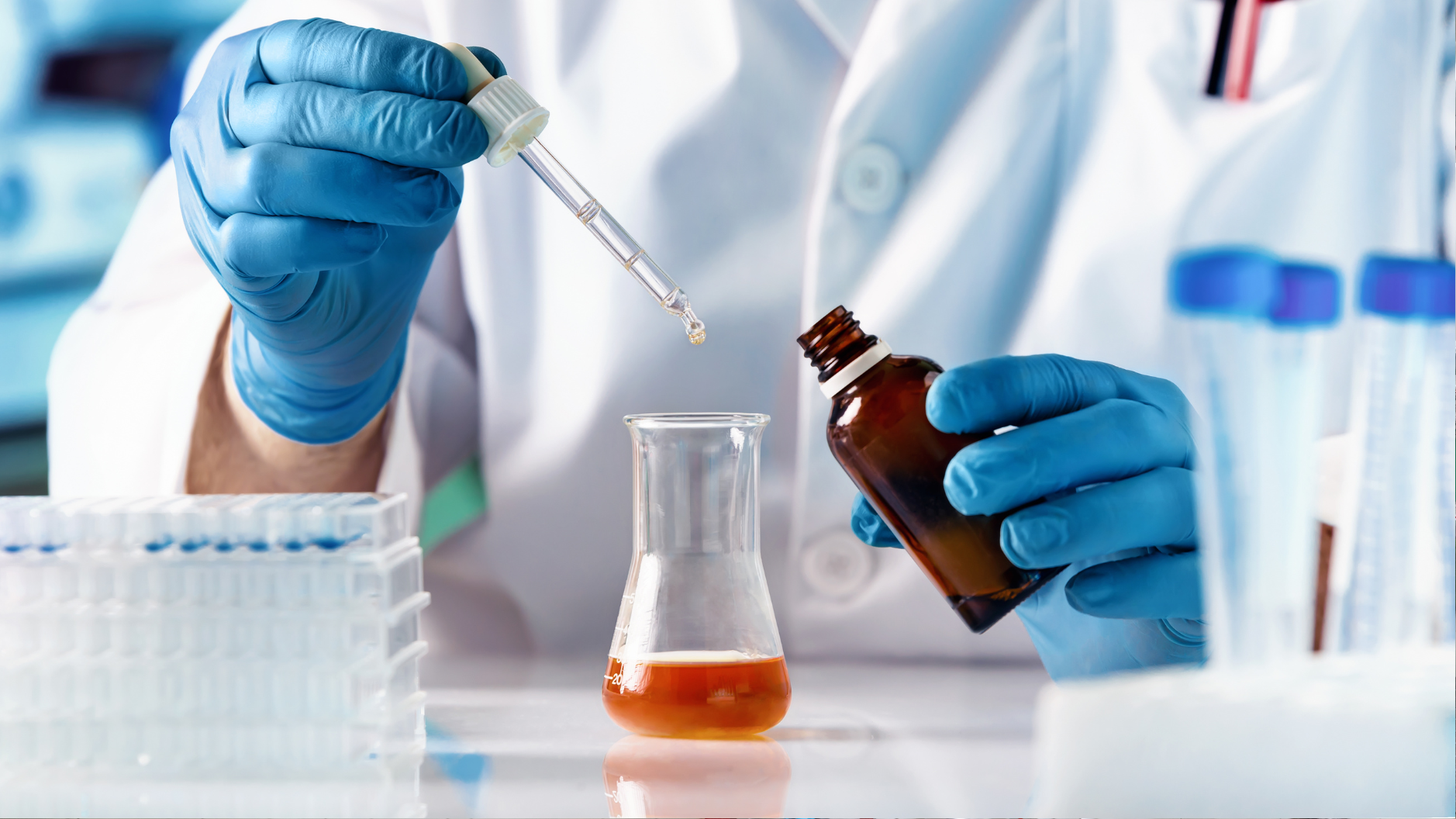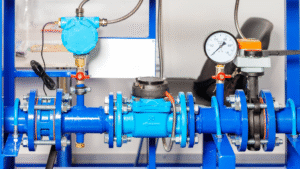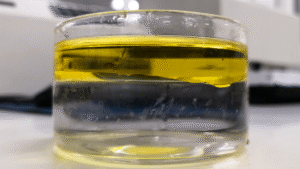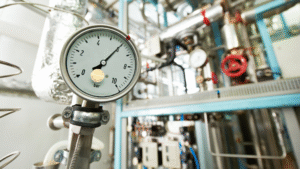Water treatment companies understand that long-term water stability in facilities – whether it is a hospital, manufacturing facility, food and beverage plant, or refinery – is central to operational efficiency. When you control alkalinity, systems are more stable and less vulnerable, preventing performance issues. With our three decades of experience in chemical blending, the ETI team knows that precision alkalinity management is vital—especially in boilers, closed-loop systems, and industrial processes—where chemistry must remain in balance. This guide breaks down why alkalinity control matters and the most effective chemical tools to maintain optimal system performance.
Key Takeaways
- Alkalinity is operational. Keeping alkalinity in check is critical to corrosion control, scale prevention, and system reliability across both boiler and wastewater systems.
- The right chemical makes all the difference. From sodium bicarbonate to phosphate blends, alkalinity control relies on tailored chemical selection based on system type, load, and performance goals.
- Monitoring equals mastery. Routine testing and precise dosing are the backbone of alkalinity control — without them, even the best chemicals fall short. For optimum results, these treatments should be precisely dosed into the boiler system, ensuring proper alkalinity to prevent corrosion and scale formation.
Importance of P-Alkalinity Measurement and Control
Maintaining appropriate alkalinity assists system reliability, chemical stability, and compliance with water quality standards. When water alkalinity falls out of range, both biological and mechanical systems suffer, often leading to expensive consequences. Hence, alkalinity poses its importance in:
- Corrosion Prevention — Low alkalinity increases acidity, accelerating metal corrosion in piping and equipment. Consistent monitoring and buffering minimize this risk and extend component life.
- Water Quality Improvement — Alkalinity supports coagulation and flocculation processes, which are critical for removing impurities and improving filtration in drinking and process water systems.
- Enhancement of Chemical Efficiency — Many additives (dispersants, biocides, phosphates) rely on specific pH and alkalinity conditions to function optimally. Stable alkalinity ensures consistent treatment performance.
- Regulatory Compliance & Public Safety — Balanced water chemistry helps meet discharge permits, prevent infrastructure degradation, and support safe water use.
Proper dosing methods, such as installing a bypass pot feeder in the boiler feed line, are essential for maintaining optimal water conditions and effective corrosion and scale control.
Chemical Options for Alkalinity Control in Boilers
In boiler systems, especially those operating at low to medium pressures—alkalinity serves two key purposes: buffering acidic compounds and enabling the precipitation of hardness ions (like magnesium and calcium salts). This protects against corrosion, scale formation, and chemical imbalance that leads to carryover or foaming.
Key Chemicals Used in Boiler Alkalinity Control:
- Alkalinity Builders: These are the primary alkalinity control agents. Sodium hydroxide, sodium carbonate, and phosphate-based builders raise pH and buffer the system — preventing low-pH corrosion and helping maintain optimal water chemistry in low- and medium-pressure boilers.
- Phosphate Treatments: While primarily used for hardness control (precipitating magnesium and calcium salts), trisodium phosphate also contributes to alkalinity and buffering capacity, especially in phosphate-based treatment programs.
- Condensate Line Treatments: Neutralizing amines don’t boost alkalinity in the boiler itself, but they raise pH in the return condensate. This helps reduce acid corrosion from CO₂ and indirectly supports overall system alkalinity balance.
These chemicals work by increasing the hydroxide or carbonate alkalinity in the system, raising the pH into a safe operating range, typically between 9.0 and 11.0, depending on system design and pressure. When properly managed, this increase in boiler water alkalinity helps:
- Prevent acid attack and metal corrosion
- Improve precipitation of calcium salts/magnesium for easier blowdown removal
- Stabilize other additives (like dispersants and oxygen scavengers)
- Minimize carryover and maintain steam quality
Chemical Options for Alkalinity Control in Wastewater
In biological wastewater treatment systems—particularly those involving nitrification, denitrification, and anaerobic digestion—alkalinity plays a foundational role in buffering against pH drops. When alkalinity is depleted, microbial populations (especially nitrifiers) can become inhibited or die off entirely, leading to treatment failure and permit violations.
To maintain stable pH and ensure biological process performance, targeted alkalinity control chemicals are used. These compounds replenish buffering capacity consumed by microbial metabolism and acid-generating reactions.
Key Chemicals for Alkalinity Control:
1. Sodium Bicarbonate (NaHCO₃)
A widely used buffering agent in wastewater systems. Sodium bicarbonate gently raises alkalinity without drastically shifting pH, making it ideal for sensitive biological environments like nitrifiers.
- Benefits: Safe handling, low impact on pH spikes, effective in small-to-medium corrections
- Best Use: Activated sludge and nitrification systems with gradual alkalinity loss
2. Soda Ash (Sodium Carbonate, Na₂CO₃)
A stronger alkalinity booster compared to bicarbonate. It increases both alkalinity and pH and is often used where faster correction is required.
- Benefits: Cost-effective, fast-acting
- Caution: May overshoot pH if not properly dosed
3. Magnesium Hydroxide (Mg(OH)₂)
Provides significant alkalinity with minimal solubility, resulting in a long-lasting buffering effect. It also contributes magnesium ions that can support certain biological processes.
- Benefits: Sustained alkalinity release, minimal pH overshoot
- Best Use: Systems with high acid production or shock loads
4. Lime (Calcium Hydroxide, Ca(OH)₂)
A traditional and powerful alkalinity agent used to raise pH and provide strong buffering. Effective in large-scale municipal or industrial wastewater applications.
- Benefits: High neutralizing capacity
- Caution: Can create handling and scaling issues; often requires slurry feed systems
5. Caustic Soda (Sodium Hydroxide, NaOH)
Highly soluble and fast-acting. Often used in emergencies to rapidly raise pH and alkalinity.
- Benefits: Immediate correction
- Caution: Corrosive and can cause pH spikes; should be dosed carefully
6. Custom Alkalinity Blends
ETI offers blended chemical solutions designed to deliver balanced alkalinity and pH correction tailored to system dynamics. These may combine buffering agents for stability with neutralizers to counter acid loads.
Application Tip: Nitrification consumes ~7.14 mg of alkalinity (as CaCO₃) for every 1 mg of ammonia converted. If this loss isn’t replenished, biological treatment performance drops off. Regular alkalinity monitoring—ideally automated—is essential for maintaining treatment reliability and compliance.
Techniques for Alkalinity Control in Water and Wastewater Systems
Alkalinity management is more than dosing chemicals—it’s a continuous process that assists in blends monitoring, adjustment, and operational discipline.
Chemical Additives
The most direct and adjustable method for alkalinity control is chemical dosing. ETI’s water treatment partner companies and facility operators select and utilize chemicals based on system needs, with frequent testing to fine-tune concentrations. Choice of chemical blend depends on:
- System size and complexity
- Biological vs. mechanical treatment goals
- Safety and handling concerns
- Cost per unit alkalinity delivered
Blowdown Process (Boiler Systems)
In steam systems, blowdown is essential for managing alkalinity and TDS levels:
- Surface blowdown targets dissolved solids at the boiler’s upper levels.
- Bottom blowdown removes sludge and precipitated minerals. Optimized blowdown schedules reduce scaling, foaming, and corrosion risk while preserving water and chemical efficiency.
Process Optimization & Monitoring
Alkalinity control must be data-driven:
- Regular monitoring of pH, total alkalinity, and conductivity
- Automated control systems (where feasible) to adjust feed rates
- Adjusting coagulant or nutrient dosing based on microbial demand
- Coordinating alkalinity targets with biological loading and system temperature
Great Systems Start with the Right Chemistry
Whether you’re protecting a high-pressure steam boiler or optimizing a biological treatment process, alkalinity control remains one of the most critical factors in water treatment success. The right chemistry, applied with precision, assists in stabilizing pH, reduces corrosion risk, improves chemical performance, and supports environmental compliance. With routine monitoring and thoughtfully selected chemical programs to control alkalinity, facilities can operate more efficiently, increase equipment life, and reduce unplanned downtime.
At ETI, we specialize in chemical blending solutions that align with the real-world demands of water treatment professionals. Our technical team brings deep experience in boiler water chemistry, wastewater systems, and dewatering processes—and we’re here to simplify the complex. Let ETI’s experts help you fine-tune your alkalinity control.
Frequently Asked Questions (FAQs)
1. What’s the ideal alkalinity control range for boiler systems?
For low- to medium-pressure boilers, total alkalinity is typically maintained between 300–700 ppm as CaCO₃, depending on system pressure and chemical program design.
2. How does alkalinity affect microbial activity in wastewater?
Alkalinity buffers the acids produced during biological processes like nitrification. Without it, pH drops and microbial performance — especially ammonia removal — deteriorates rapidly.
3. What’s the difference between sodium carbonate and sodium bicarbonate?
Sodium carbonate (soda ash) raises both pH and alkalinity quickly, while sodium bicarbonate provides a gentler alkalinity boost with minimal pH impact — ideal for sensitive biological systems.
4. Can high alkalinity in boiler water be harmful?
Yes. Excessive alkalinity can lead to scaling, foaming, or high TDS in boilers, and can inhibit coagulation in water treatment. That’s why balance and blowdown are critical.
5. How often should alkalinity be monitored?
In most systems, daily or continuous monitoringof alkalinity is recommended, especially in boilers and high-load wastewater facilities. Automated controllers can adjust feed rates based on real-time data.






